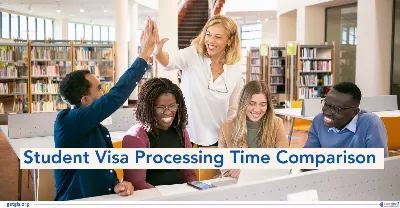CPT vs OPT: Meaning and Differences for International Students
Updated On
-
Copy link
CPT vs OPT highlights two work authorization options for F-1 students in the USA. CPT allows practical training during studies, while OPT provides work opportunities after graduation, including a STEM extension of up to 24 months.
Limited-time offer : Access a free 10-Day IELTS study plan curated for you

Table of Contents
The debate of CPT vs OPT often comes up among international students in the USA who want to gain practical work experience during or after their studies. Curricular Practical Training (CPT) allows students to work in jobs directly tied to their academic program while still enrolled, often through internships or cooperative education.
Optional Practical Training (OPT), on the other hand, gives students up to 12 months of work authorization after graduation, with STEM graduates eligible for a 24-month extension. Both options are overseen by USCIS and have strict rules on eligibility, duration, and application timelines. Let’s dive deeper into their details of the two pathways.
CPT vs OPT: Top Differences
A key distinction between OPT and CPT lies in their timing; OPT is granted during a program, while CPT is only available post-completion. Additionally, OPT employment must align with the academic program, and OPT can extend up to 24 months, contrasting with CPT's maximum duration of 12 months. Here are the major differences between CPT and OPT.
|
Factor |
CPT (Curricular Practical Training) |
OPT (Optional Practical Training) |
|
Purpose |
Enables F-1 students to gain hands-on experience related to their course while studying |
Provides F-1 students with work authorization in their field after completing their studies |
|
Requirement |
Must be part of the degree curriculum and approved by the university |
Independent of curriculum requirements, pursued after graduation |
|
Timing |
Available while enrolled in the academic program |
Usually begins once the degree is completed |
|
Relevance to Studies |
Work must directly connect to the student’s academic program |
Employment must align with the student’s major, even after graduation |
|
Authorization |
Needs approval from the ISS office and the academic department |
Requires USCIS authorization |
|
Application Mode |
Applied through the university’s online system |
Submitted to USCIS, either online or on paper |
|
Duration |
Up to 12 months of work authorization |
12 months standard, with an additional 24 months for STEM fields |
|
Employment Document |
No EAD card is issued by USCIS |
An EAD card is provided by USCIS after approval |
|
Application Fee |
No fee required |
Application fee: USD 470 (online) or USD 520 (paper filing) |
|
Work Hours |
Part-time (20 hrs/week) during semesters; full-time (40 hrs/week) in breaks like summer |
full-time post-graduation |
|
Employer Flexibility |
Students may work with any US employer |
Limited to employers listed in SEVIS and on the student’s I-20 |
Also Read: Everything You Need to Know About Intakes in USA
Employment Authorization Options for International Students
International students have various employment authorization options to participate in practical experiences. Generally, unpaid work and internships are permitted under F-1 and J-1 student statuses without additional authorization.
It is advisable for international students to consult their university's international office to ensure compliance and avoid unfair or unlawful unpaid work arrangements.
Prior to participating in any employment, international students must ensure proper authorization. This can be an inherent benefit of their status, granted by the school's international office, or approved by USCIS (United States Citizenship & Immigration Services).
Several types of employment authorization are accessible to international students, with some widely utilized forms being:
- On-campus Employment
- Curricular Practical Training (CPT)
- Optional Practical Training (OPT)
On-Campus Employment
F-1 and J-1 international students have the authorization to work on-campus at the school that issued their I-20 throughout their program.
On-campus employment is not restricted to the student's area of study, offering the flexibility to gain experience, enhance professional skills, or explore diverse interests.
|
*Note: While classes are in session, F-1 and J-1 students are allowed to work up to 20 hours per week on-campus, and during official school breaks and vacation quarters, they can work more than 20 hours per week. |
Quick Read: Cost of Study in USA for Indian Students in 2026
What is Curricular Practical Training (CPT)?
CPT, or Curricular Practical Training, grants temporary work authorization for F-1 visa students, offering practical experience through internships related to their major.
This employer-specific training must be completed before graduation, but working full-time for 12 months under CPT may impact OPT eligibility.
Key CPT Features
The key features of Curriculum Practical Training (CPT), are as follows:
- CPT usage is confined to one's academic program, up to the I-20 end date.
- Authorization is granted by the university's international office, specifying the time period and employer.
- No restrictions on the number of times eligible students can engage in part-time (less than 20 hours per week) or full-time (more than 20 hours per week) CPT.
- Students considering the CPT to OPT transition should note that exceeding 12 months of full-time CPT renders them ineligible for OPT at the same degree level. Part-time CPT, however, does not affect OPT eligibility.
Eligibility Requirements for CPT
To qualify for CPT, international students must qualify for the minimum eligibility, which includes:
- Maintain valid F-1 Status.
- Be enrolled full-time for at least one academic year before starting work.
- Enroll in a degree program at a recognized, SEVP-certified U.S. institution of higher education.
- Secure a specific job offer meeting the school's criteria for the relevant course, degree, or cooperative opportunity.
Documents Requirements for CPT
Here are the documents required to apply for CPT.
- Certificate of completion for the CPT online workshop
- Recommendation form provided by your academic advisor or department
- Detailed training outline submitted by the employer
- Current and valid copy of the I-20 form
- Printed copy of your electronic I-94 record.
Suggested Reading: STEM Courses in the USA
What is Optional Practical Training (OPT)?
OPT, or Optional Practical Training, is a versatile program aligned with an F1 visa holder's major field of study. It permits full-time employment for 12 months, and for STEM degree seekers, this duration can extend to 17 months.
Key OPT Features
The key features of Optical Practical Training (OPT), are as follows:
- After completing the full OPT period, students are ineligible to apply for CPT.
- Pre-completion OPT (before the I-20 end date) can be part-time or full-time.
- Post-completion OPT (before the I-20 end date) is exclusively full-time.
- F-1 students completing their program can apply for post-completion OPT through USCIS, usually 3 months before the course completion date up to a month after fulfilling degree requirements.
- For those with prior pre-completion OPT, USCIS deducts this time from post-completion OPT authorization.
- When ready to apply for OPT, students can seek guidance from their university's international office for the application process and materials.
Eligibility Requirements for OPT
To qualify for OPT, international students must qualify for the minimum eligibility, which includes:
- Maintain valid F-1 status.
- Be enrolled full-time for at least one academic year before commencing work.
- Enroll in a degree program at a SEVP-certified U.S. institution of higher education.
- Intend to work directly related to their field of study (although a job offer is not mandatory for application).
- Not have utilized 12 or more months of full-time CPT.
- Not have exhausted 12 months of full-time OPT at the same degree level, nor any OPT at a higher degree level.
Documents Requirements for OPT
Find below the list of documents required to apply for OPT.
- Two recent passport-sized photographs
- Completed and signed Form I-765 (original copy)
- A photocopy of your valid passport
- Printed copy of your I-94 record
- Personal check for USD 380 (amount may vary) payable to the Department of Homeland Security
- Copy of your current I-20 with CPT recommendation
- Copies of all previously issued I-20 forms
- Copies of any Employment Authorization Documents (EAD) received earlier
- Passport page showing the F-1 visa stamp
Must Read: MS Courses in the USA 2025
What is STEM OPT Extension?
The STEM OPT Extension grants a 24-month extension to students pursuing degrees in STEM fields—Science, Technology, Engineering, and Mathematics.
This extension provides temporary training directly related to an F-1 student's program of study, offering valuable work experience for practical application.
Eligibility Requirements for STEM OPT Extension
To be eligible for the 24-month STEM OPT extension, students must meet the following criteria:
- Hold F-1 international student status.
- Currently in the STEM OPT period.
- Possess a bachelor's or higher degree in an eligible STEM field in the U.S.
- The employer must participate in the E-Verify program.
- Both the employer and the employee must sign Form I-893, also known as the 'Training Plan for STEM OPT Students.
Also Read: Spring Intake in the USA 2025
CPT vs OPT: Navigate Through the International Student Landscape
In the dynamic landscape of international student employment, understanding the distinctions between CPT and OPT is pivotal. From eligibility criteria to usage constraints, each program offers unique opportunities and considerations.
Careful navigation of these paths ensures students make informed choices, maximizing the benefits of practical training during and after their academic pursuits in the United States.
Need further assistance with your study abroad and immigration needs? Look no further than GetGIS for personalized and dedicated immigration guidance.
Quick Links for You:
Limited-time offer : Access a free 10-Day IELTS study plan curated for you

Frequently Asked Questions
Does CPT Impact OPT?
Can I simultaneously apply for CPT and OPT applications?
What is a Cap-Gap Extension?
Can I switch from CPT to OPT?
Can I work for 20 hours under OPT?





